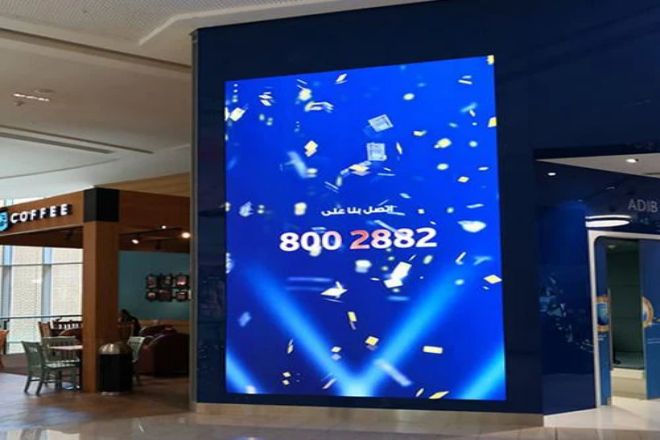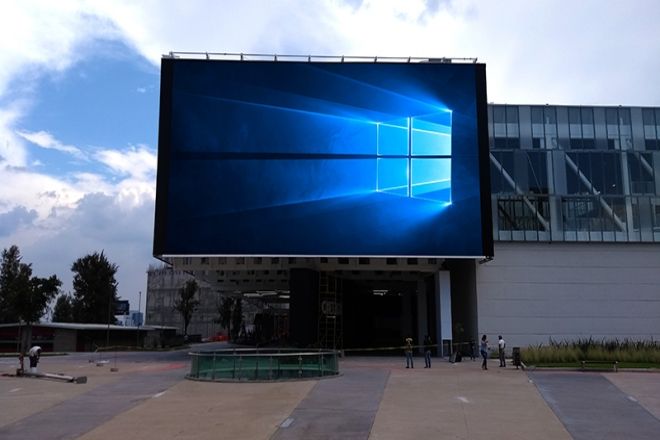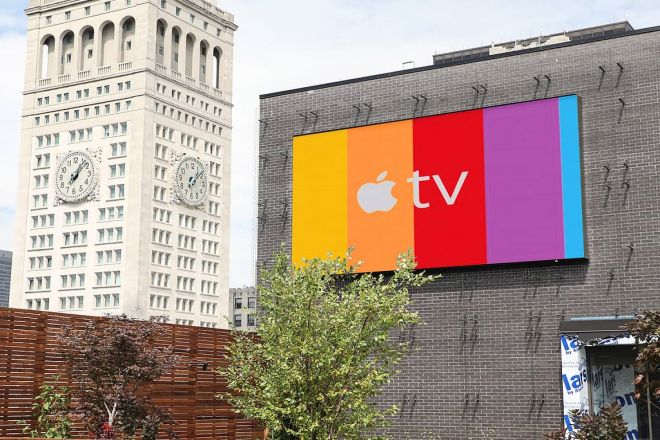Introduction

In the ever-changing business world, the brand is not only a symbol of corporate identity but also an emotional bond between consumers and products. For newly established companies, quickly standing out in the fierce market competition and establishing a unique brand image have become the keys to corporate development.
With the advancement of technology, LED display screens, as an efficient and flexible visual communication tool, are gradually becoming a new favorite for brand building. Its excellent display effect, unlimited creative space, and strong interactive ability provide new companies with unlimited possibilities to create a personalized and differentiated brand image.
1. The unique value of LED display screens in brand building

- Visual impact: creating an unforgettable first impression
LED display screens stand out among many promotional media with their high brightness and high resolution. In busy commercial streets, exhibition sites, or public places with large traffic, LED display screens can instantly attract the attention of passers-by and become the focus.
This strong visual impact can not only effectively increase brand exposure but also form a deep first impression in the hearts of customers.
High-definition picture display makes brand information more delicate and vivid, which helps customers remember the brand the first time and lays the foundation for subsequent brand recognition and loyalty.
- Dynamic display capability: Enhance the fun and interactivity of brand information
Compared with traditional static advertisements, LED display screens have the ability to play videos, animations, real-time data, and other diversified content.
This dynamic display method not only enriches the form of brand information communication but also greatly enhances its fun and interactivity. Enterprises can vividly display brand stories, product features, or market activities through carefully designed video advertisements, animation demonstrations, or real-time data displays, attracting customers to stop and watch and actively participate.
At the same time, dynamic displays can effectively avoid visual fatigue and keep customers fresh and interested in brand information.
- Flexibility and adaptability: Meet the needs of brand communication in different scenarios
LED display screens have extremely high flexibility and adaptability and can easily adapt to the needs of brand communication in various scenarios. Whether indoors or outdoors, whether it is an exhibition, a store, or an outdoor advertising space, LED display screens can be customized according to environmental characteristics and brand needs.
Installation and display. In addition, LED display screens also have the ability to quickly update content. Enterprises can adjust the display content at any time according to market changes, seasonal changes, or promotional activities to maintain the timeliness and pertinence of brand information.
This flexibility and adaptability make LED display screens an indispensable and important tool in brand communication.
- Fusion of technology and creativity: Showing the brand’s innovative image
As a representative of modern technology products, the LED display itself contains a strong sense of technology. When it is combined with creative content, it can show the brand’s unique, innovative image.
Enterprises can make full use of the technical advantages of LED display screens, combined with advanced visual effects, animation technology, and interactive design, to create a refreshing brand display effect.
This deep integration of technology and creativity can not only attract customers’ attention but also make them feel the brand’s innovative spirit and sense of the future, thereby deepening their understanding and favorability of the brand.
2. How new companies use LED display screens to create brand themes
1). Clear brand positioning and core information
- Analyze the target audience:
First, the new company needs to have an in-depth understanding of the age, gender, interests, consumption habits, and other characteristics of its target audience in order to accurately position the brand.
Through market research and data analysis, clarify the needs and preferences of the target audience, and provide a strong basis for determining the brand tone.
- Determine the brand tone:
According to the characteristics of the target audience and market demand, the new company should determine the unique tone of the brand, such as high-end, fashionable, young, and energetic.
The brand tone should be consistent with the psychological expectations of the target audience to enhance the brand’s appeal and identity.
- Refine the core information of the brand:
On the basis of clarifying the brand tone, the new company should further refine the core information of the brand, including brand concept, values, product features, etc.
This information should be concise and powerful, easy to remember and spread, and become an important symbol of brand recognition. At the same time, design a concise and powerful slogan or slogan as the finishing touch of brand communication.
2). Creative content planning
Focusing on the brand theme:
The new company should focus on the brand theme closely and plan a series of creative and attractive visual content. These contents should cover a variety of forms, such as static pictures, dynamic videos, interactive games, etc., to enrich the way of conveying brand information.
- Tell the brand story:
Use storytelling techniques to integrate the brand’s development history, the story behind the product, or the brand concept into the visual content. Through vivid storytelling, enhance the emotional connection between the brand and consumers, and enhance the brand’s affinity and identity.
- Incorporate hot elements:
Pay attention to social hot spots and popular trends, and integrate relevant elements into the brand’s visual content. This can not only improve the timeliness and topicality of the content, but also attract more attention and discussion, and expand the influence of the brand.
3). Choose the right location and form of LED display.
- High-traffic areas:
According to the brand positioning and target market, choose high-traffic areas to install LED display screens. These areas usually have high exposure and attention and can convey brand information more effectively.
- Optimize the display effect:
Consider factors such as the size, shape, and resolution of the display to ensure that the best visual effect can be presented in different scenes. At the same time, pay attention to the coordination and integration with the surrounding environment to avoid a sense of abruptness.
- Evaluate the display method:
Evaluate the advantages and disadvantages of outdoor and indoor display screens and choose the most suitable display method according to brand needs and actual conditions.
Outdoor display screens have higher exposure and visual impact, but attention should be paid to protective measures such as waterproofing and dust proofing; indoor display screens pay more attention to picture quality and clarity and are suitable for close viewing.
4). Technical implementation and post-maintenance
- Professional cooperation:
Cooperate with professional LED display screen suppliers to ensure the feasibility and stability of technical solutions. Select suppliers with rich experience and a good reputation to ensure that the quality and performance of the display screen meet the expected requirements.
- Content update plan:
Develop a detailed content update plan and regularly replace the content on the display screen to keep it fresh and attractive. At the same time, based on market feedback and data analysis results, continuously optimize content strategies and improve communication effects.
- Establish a maintenance mechanism:
Establish a regular maintenance mechanism to clean, inspect, and repair the display screen. Ensure the long-term stable operation of the display screen to avoid affecting the brand image due to failure or damage.
5). Integrated marketing communication
- Multi-channel linkage:
Combine LED display screen display with other marketing channels such as online social media and offline activities to form a three-dimensional brand communication network. Through multi-channel linkage, expand the brand’s coverage and influence and enhance brand awareness and reputation.
- Data analysis optimization:
Use data analysis tools to evaluate and analyze the display effect of LED display screens. By collecting data indicators such as user feedback, viewing time, and click-through rate, understand user behavior and preferences and provide strong support for subsequent marketing strategy optimization.
3. Challenges and coping strategies

1). Challenges
1.1). Cost control:
High initial investment: LED display screens, especially large-size, high-resolution display screens, often have high purchase and installation costs, which may pose greater financial pressure for new companies.
Operation and maintenance costs: In addition to the initial investment, the daily operation, content update, and maintenance of the LED display screen also require continuous capital investment, which increases the company’s operating costs.
1.2). Content creativity:
Creative exhaustion: Keeping the content fresh and attractive for a long time requires continuous creative support, and the exhaustion of creativity may become a major problem for new companies.
Content homogeneity: In the fierce market competition, how to avoid content homogeneity with other brands and form a unique brand style is also a problem that new companies need to solve.
1.3). Technical difficulties:
Rapid technological updates: LED display technology is changing with each passing day, and new companies need to keep up with technological updates to ensure that the performance and effects of the display screen remain leading.
Technical failures and maintenance: The display screen may encounter various technical failures during operation. How to quickly respond to and solve these problems and ensure the normal operation of the display screen is a technical challenge that new companies must face.
2). Response strategies
2.1). Strengthen cost control awareness:
Reasonable budget planning: Before purchasing and installing LED display screens, new companies should fully investigate the market, reasonably plan budgets, and ensure maximum return on investment.
Optimize resource allocation: Reduce operating costs by optimizing content update plans and improving the efficiency of display screens.
2.2). Cultivate a creative team:
Form a professional team: Recruit talents with creative talents and professional skills, form a professional creative team, and be responsible for content planning and design.
Continuous learning and communication: Encourage team members to participate in training, seminars, and other activities to broaden their horizons and inspire creativity. At the same time, strengthen communication and cooperation with other creative teams, share resources, and improve the overall creative level.
2.3). Establish a technical partnership:
Choose reliable suppliers: Establish long-term cooperative relations with LED display suppliers with rich experience and good reputations to ensure the quality and performance of the display.
Technology sharing and collaboration: Establish close cooperative relations with suppliers, technical service providers, etc., jointly solve technical problems and promote technological innovation. At the same time, use the technical advantages of partners to improve their own technical level and response capabilities.
2.4). Flexibly respond to market changes:
Pay attention to market dynamics: Pay close attention to market trends and competitor dynamics, and adjust brand communication strategies and content directions in a timely manner.
Diversified communication channels: In addition to LED display screens, new companies should also actively explore other communication channels, such as social media, offline activities, etc., to form a diversified brand communication network and reduce the risk of dependence on a single channel.
By implementing the above coping strategies, new companies can more effectively cope with various challenges encountered in the process of using LED display screens, give full play to their unique value in brand building, and achieve rapid development and improvement of brands.
Conclusion
In summary, as an indispensable visual communication tool in the modern business environment, LED display screens provide unprecedented opportunities and challenges for new companies’ brand building.
Through precise brand positioning, creative content planning, reasonable location selection and form design, and integrated marketing communication strategies, new companies can make full use of the unique advantages of LED display screens to create an unforgettable brand image.
Finally, if you want to know more about LED display screens, please get in touch with us.
